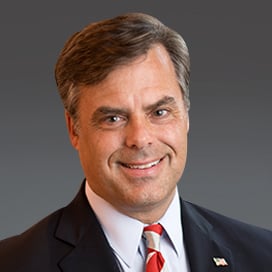
Matt Wetzel 
William Jackson
Featured Expert Contributor—Life Sciences and Medtech Regulation
Matt Wetzel and William Jackson are partners in the Washington, DC office of Goodwin Procter LLP.
Ed. Note: This is Matt Wetzel’s debut commentary as a featured expert contributor in a new topic area for the WLF Legal Pulse. Prior to joining Goodwin Procter, Matt held several executive positions in the life-sciences industry, including Vice President and Deputy General Counsel at the trade group AdvaMed; Associate General Counsel & Chief Compliance Officer of GRAIL, Inc.; and Senior Counsel, Global Compliance & Ethics, Boston Scientific. Welcome aboard, Matt!
***
Many of us in the life-sciences regulatory world are awaiting an impending decision in a recent federal lawsuit brought by Pfizer. Pfizer is challenging federal government limits on drug makers’ ability to offer assistance to help the uninsured and underinsured, including Medicare and Medicaid beneficiaries, obtain prescription medications that may be otherwise too expensive for them. Drug makers’ assistance can come in a number of different forms, but often can be a copay coupon or payment voucher that helps reduce or eliminate a patient’s copay obligations. Other financial support programs involve drug makers donating funds to independent non-profit charities that, in turn, pay for qualified patients’ copays and provide other types of tangible support. These independent non-profits—also known as patient assistance programs, or PAPs—regularly aid patients with rare diseases or who face particularly significant costs and other challenges in connection with a diagnosis.
The U.S. Department of Health & Human Services Office of Inspector General, or OIG, has made it clear: cost-sharing support like copay assistance for Medicare beneficiaries is not permissible except in limited circumstances. The government views cost-sharing and copays as creating a natural economic restraint on drug prices. The idea is that if patients have skin in the game, so to speak, the government believes they will think twice before opting for the most expensive brand name drug, especially when a cheaper generic is available. The government’s theory is that, by providing copay assistance, the prescription manufacturers are engaging in a kickback scheme—in which the lack of a copay causes the patient to opt for the more expensive product, thereby generating a sale that wouldn’t have occurred without the copay assistance. Pfizer’s suit tests these limits.
The government’s stance can be found in a number of different locations. For decades, OIG has informed providers, pharmacies, drug makers, PAPs, and others how they can support financially needy patients without running afoul of these restrictions. OIG’s position can be found across dozens of advisory opinions on the topic, three “Special Advisory Bulletins” addressing cost-sharing and copay waivers, and numerous integrity agreements with drug companies and PAPs that have settled kickback cases, agreeing to adopt stricter internal controls around PAP-related activities. OIG has gone so far as to revise and update past advisory opinions related to PAPs to keep track with its own evolving guidance.
But despite this guidance, the last several years has seen the government settling kickback case after kickback case against drug makers and PAPs. In these cases, the government alleges that drug makers and independent PAPs have conspired to pay kickbacks. Put another way, donations paid from drug makers to charities, according to the government, were intended to cover only the cost-sharing obligations of Medicare beneficiaries who were taking the donor’s own products and not another product that could have been prescribed instead. Because payment was routed through the independent PAP, all patients, even those who might not qualify to have their co-pays waived due to financial need, were able to access the drug at no cost or much lower cost.
This is not just a simple case of bad actors refusing to comply with the law. Part of the problem is that the government’s direction on the topic, while plentiful, is also complicated and spread across a series of evolving informal guidance documents. There is no established set of authoritative guidelines on which stakeholders can rely. Instead, the government’s stance is detailed through a number of advisory opinions, bulletins, and settlement agreements. But stakeholders are told that, for example, only the party seeking an OIG advisory opinion can rely on it. Adding to the confusion are government settlements and corporate integrity agreements, which contain detailed descriptions of controls for PAP-related arrangements that the government finds to be acceptable—even desirable. But these controls are found in dense settlement agreements that few bother to read, and the government’s press releases about those settlement agreements provide no additional direction or support. In short, companies seeking to fund PAPs in a compliant way must trudge through a morass of opinion letters, bulletins, and settlement agreements to distill for themselves any kind of common principles.
While claims that a Pfizer win in its current case would destroy or decimate the government’s controls on Medicare spending are likely over-dramatized, one point is clear: the government’s efforts to date at regulating the practice have been driven not by clear regulations subject to comment and rulemaking but instead by responding to requests for advisory opinions, as well as costly and lengthy investigations. As such, from the companies’ perspective, the process is overly complicated and insufficiently clear. In fact, the best result from the Pfizer case would be a commitment from OIG to reevaluate the maze of informal guidance that it has issued over the years and provide clear instruction to stakeholders.
The next generation of challenges is on its way: additional private litigation. In July 2021, Humana sued Regeneron in federal court. The insurance company alleges that the drug company’s copay assistance program amounted to fraud. The suit leverages DOJ’s allegations that charity payments from Regeneron to the Chronic Disease Fund (a PAP) were kickbacks to cover cost-sharing obligations of Regeneron’s Eylea product (vs. competitor products). Humana is essentially piggybacking on the DOJ’s investigation in an effort to recoup money Humana paid for Regeneron over time. As such, the next round of challenges will involve private parties fighting amongst themselves about the scope and import of the government’s position that these programs are improper.
Each year, OIG issues a public request for suggested new safe harbors to the Anti-Kickback Statute. Safe harbors are regulations that describe arrangements that could be shielded from Anti-Kickback Statute liability. Those regulations would be subject to standard notice-and-comment rulemaking, and could provide companies in one place a clear set of guidelines on the permissible scope of PAPs. The time is now for OIG to consider a safe harbor for drug maker support of independent patient assistance programs. A new safe harbor could—in one place and with uniformity—describe the extent to which funding can be used towards Medicare beneficiaries’ cost-sharing obligations. A new safe harbor could establish specific criteria and structural considerations for drug makers and others to follow in providing grants to independent PAPs. It could address things like the appropriate duration of cost-sharing support and how to define “financially indigent.” It could describe controls around funding single disease or single drug funds. It could also establish the rules and controls that PAPs must put in place to help the uninsured and underinsured while staying free from any external influences. A formal safe harbor would allow manufacturers and PAPs an opportunity to structure funds in a way that balances the strong public policy need for supporting financially needy patients, including Medicare beneficiaries, against the increased risk of running afoul of the kickback statute.
Finally, and perhaps most importantly, a new safe harbor—promulgated through notice-and-comment rulemaking—would help ensure that all stakeholders’ voices are taken into account, including those of the drug makers and of the patients who require financial support.
